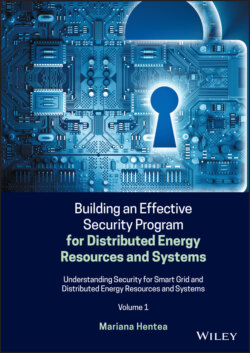Читать книгу Building an Effective Security Program for Distributed Energy Resources and Systems - Mariana Hentea - Страница 20
1.2.3 Drivers for Change
ОглавлениеExamples of drivers for change in the electric power system in the United States include:
Integration of Smart Grid technologies (see definition in Appendix B) for managing complex power systems, driven by the availability of advanced technologies that can better manage progressively challenging loads.
Growing expectations for a resilient and responsive power grid in the face of more frequent and intense weather events, cyber and physical attacks, and interdependencies with natural gas and water systems.
Smart Grid technologies and applications encompass a diverse array of modern communications, sensing, control, information, and energy technologies that are already being developed, tested, and deployed throughout the grid. These technologies are divided into three basic categories [NSF 2011]:
Advanced ICTs (including sensors and automation capabilities) that improve the operation of transmission and distribution systems.
Advanced metering solutions, which improve on or replace legacy metering infrastructure.
Technologies, devices, and services that access and leverage energy usage information, such as smart appliances that can use energy data to start operating when energy is cheaper or renewable energy is available.
The Smart Grid vision increases the use of IT systems, networks, and two‐way communication to automate actions that system operators formerly had to perform manually.
Thus, the grid modernization is an ongoing process, and initiatives have commonly involved installing advanced metering infrastructure (AMI) (smart meters) in homes and commercial buildings that enable two‐way communication between the utility and customer. Other initiatives include adding smart components to provide the system operator with more detailed data on the conditions of the transmission and distribution systems and better tools to observe the overall condition of the grid (referred to as wide area situational awareness). These components include advanced smart switches on the distribution system that communicate with each other to reroute electricity around a troubled line and high‐resolution, time‐synchronized monitors, called phasor measurement units, on the transmission system. Concepts such as smart loads, smart generation distribution, smart electric vehicles (EVs), smart buildings, and smart switch are enabling a smarter grid [DOE 2015a]. Figure 1.7 illustrates a Smart Grid configuration, with common smart components (smart meter, smart appliances, phasor measurement unit, wind turbines, electric vehicle, smart switch, two‐way communication lines), although utilities making Smart Grid investments may opt for alternative configurations depending on cost, customer needs, and local conditions.
Figure 1.7 Common Smart Grid components.
Source: [GAO 2011]. Public Domain.
To deliver electricity more cost effectively in response to consumer needs and at the same time with less damage to the climate, the Smart Grid uses distributed energy resources (DERs), advanced communication, and control technologies.
